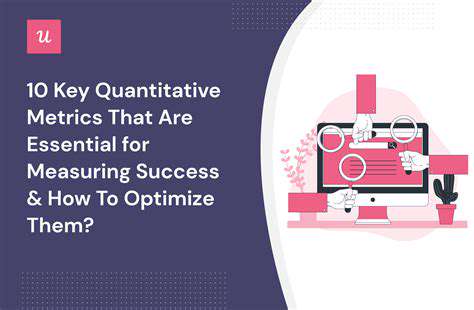The Influence of Social Proof and Influencer Marketing
Understanding Social Proof
Social proof, a cornerstone of human psychology, plays a significant role in shaping our decisions, particularly online. We often look to others for guidance, relying on their actions and opinions to inform our own. This inherent tendency is exploited in various online marketing strategies, including influencer marketing. Understanding social proof allows us to critically evaluate the information we encounter online and avoid being swayed by misleading or manipulative tactics. It's crucial to discern genuine endorsements from fabricated ones, recognizing that the perceived consensus might not always reflect the reality of the situation.
The concept of social proof is rooted in the idea that if many people are doing something, it must be the right or desirable thing to do. This psychological shortcut helps us navigate complex choices and save cognitive energy. However, this can also lead to conformity and potentially harmful behaviors when presented in a skewed or manipulated way. Online, this can manifest in the form of inflated reviews, fake followers, or orchestrated campaigns designed to create a false impression of popularity.
The Power of Influencer Marketing
Influencer marketing leverages the power of social proof by connecting brands with individuals who have established credibility and influence within a specific niche. These influencers, whether celebrities, industry experts, or everyday social media personalities, often have a dedicated following who trust their judgment and recommendations. Consequently, endorsements from these influencers can significantly impact consumer purchasing decisions.
Brands recognize the potential for increased brand awareness and engagement by partnering with influencers. This strategy often involves sponsored posts, product reviews, and collaborations. The success of influencer marketing hinges on the authenticity and perceived relevance of the influencer to their audience. A genuine connection between the influencer and their followers is often more effective than a purely transactional relationship.
Identifying Authentic Influence
Distinguishing genuine influence from manufactured endorsements is crucial in the online realm. Authentic influencers often demonstrate expertise and passion in their niche, engaging with their audience in a meaningful way. They build trust by consistently providing valuable content and fostering a sense of community. Examining an influencer's engagement metrics, such as comments, shares, and follower interaction, can provide valuable insights into the authenticity of their influence. A high level of engagement often correlates with genuine connection.
Beware of overly polished or generic content. Authenticity shines through in the details, and a genuine influencer will likely have a unique voice and style. Look for consistency in the influencer's messaging and values. Their alignment with your own personal values can also be a strong indicator of a trustworthy and genuine source.
The Impact of Social Proof on Online Behavior
Social proof significantly impacts online behavior by influencing our perceptions of products, services, and brands. The perceived consensus, whether real or manufactured, can sway our purchasing decisions, subscription choices, and even our engagement in online communities. Understanding this psychological mechanism is crucial for navigating the complex landscape of online interactions.
This impact extends beyond individual purchasing decisions. The pressure to conform to social norms online can lead to a wide range of behaviors, from online shaming to the amplification of misinformation. Consumers need to develop critical thinking skills to evaluate the information they encounter and avoid being swayed by manufactured social proof.
Ethical Considerations in Influencer Marketing
The rise of influencer marketing has raised important ethical considerations. Transparency in sponsored content is paramount, and influencers have a responsibility to disclose any affiliations with brands. Misleading or deceptive practices, such as concealing sponsored posts or exaggerating product benefits, erode trust and damage the credibility of the entire influencer marketing ecosystem. Consumers need to be vigilant in discerning genuine recommendations from potentially misleading endorsements.
Another crucial aspect is the potential for harm when influencers promote products or services that are potentially harmful or misleading. Influencers have an ethical obligation to consider the potential consequences of their recommendations and avoid promoting products that could negatively impact their followers' well-being. This includes ensuring the products align with the influencer's values and are not harmful to the consumer.
The Role of Emotion and Visual Appeal: Design and Storytelling
Emotional Resonance in Design
Effective design taps into the emotional landscape of the user. By understanding the psychology of color, shape, and typography, designers can evoke specific feelings. A well-crafted design, for instance, can elicit feelings of trust and security through the use of warm colors and symmetrical shapes. Conversely, bold colors and asymmetrical layouts can communicate energy and excitement. This emotional connection is crucial for creating a meaningful experience that resonates with the user on a deeper level, ultimately driving engagement and action.
Visual Storytelling Through Design Elements
Design, at its core, is a form of visual storytelling. Careful consideration of imagery, typography, and layout allows designers to convey narratives and evoke emotions without relying on words. A compelling visual narrative can create a deeper understanding of a brand or product, and the user can often grasp the essence of a message much more quickly and effectively through visual cues. Images, icons, and even the use of negative space can be powerful tools in crafting a visual narrative that resonates with the target audience.
The Psychology of Color in Design
Color psychology plays a significant role in design, influencing user perceptions and behaviors. Different colors evoke different emotions. For example, blue often signifies trust and reliability, while red can communicate urgency and excitement. Understanding the psychological impact of color allows designers to strategically use it to influence user perception and create a desired emotional response. It's a fundamental aspect of design that often goes unnoticed but profoundly impacts user experience.
Typography and Emotional Impact
Typography, the art and technique of arranging type, is a powerful tool in design. The choice of font, its size, and its weight can profoundly influence the emotional impact of a design. A sans-serif font might convey a sense of modernity and clarity, while a serif font could evoke feelings of tradition and elegance. The interplay of these elements creates a holistic design experience, influencing user perception and reinforcing the intended message.
The Importance of Visual Hierarchy in Storytelling
Creating a clear and compelling visual hierarchy in design is essential for effective storytelling. This involves strategically guiding the user's eye through the design, highlighting key elements and drawing attention to important information. By using varying sizes, colors, and spacing, designers can emphasize certain elements, creating a clear path for the user to process the information presented. This approach improves comprehension and enhances the overall user experience.
Shape and Symbolism in Design
The deliberate use of shapes and symbols can contribute significantly to the overall narrative of a design. Different shapes can convey different meanings, and these can be used to evoke specific emotions. For example, circles often represent unity and wholeness, while squares can symbolize stability and structure. Understanding the symbolic value of shapes and incorporating them strategically into the design can amplify the message and enhance the user experience.
The Role of White Space and Negative Space in Design
White space, or negative space, often overlooked, is a crucial aspect of effective design. It provides breathing room and visual balance, preventing the design from feeling cluttered or overwhelming. By strategically using white space, designers can create a more refined and aesthetically pleasing user experience. It also highlights important elements, making the design more accessible and user-friendly. It's a powerful tool for improving the overall perception of the design and enhancing user engagement.
Retailer Tactics: Mastering the Art of Persuasion

Understanding Consumer Psychology
Retailers must deeply understand consumer psychology to effectively implement tactics. This involves recognizing the motivations, needs, and desires that drive purchasing decisions. Understanding how consumers perceive value, make choices, and react to different stimuli is critical to crafting successful strategies. This knowledge allows for the creation of targeted marketing campaigns and product displays that resonate with the intended audience. Recognizing the importance of emotional connection and creating a positive shopping experience is key to building brand loyalty.
Pricing Strategies for Maximum Impact
Effective pricing strategies are crucial for maximizing profit and attracting customers. This includes understanding the balance between perceived value and affordability. Pricing tactics such as dynamic pricing, bundle deals, and promotional offers can greatly influence consumer behavior and drive sales. A thorough understanding of market trends and competitor pricing is essential for developing competitive pricing strategies.
Strategic Product Placement
Strategic product placement is key to driving sales and enhancing the in-store experience. Carefully considering the placement of products based on customer flow and related product groupings can significantly impact sales. Well-planned displays can create a sense of discovery and entice impulse purchases. Visual merchandising plays a critical role in guiding customers to specific products and highlighting key features.
Creating an Engaging In-Store Experience
A captivating in-store experience significantly impacts customer satisfaction and loyalty. Elements like ambient music, lighting, and even the arrangement of the store layout can influence mood and perception of the brand. Creating a welcoming and enjoyable atmosphere encourages customers to linger and explore, increasing the likelihood of purchases. The use of interactive displays, knowledgeable staff, and personalized recommendations can all enhance the experience.
Building Brand Loyalty Through Customer Service
Building and maintaining brand loyalty hinges on exceptional customer service. Providing helpful and friendly assistance, addressing concerns promptly, and going the extra mile can create lasting impressions. Positive customer interactions foster trust and encourage repeat business. Offering loyalty programs and exclusive perks can further strengthen customer relationships and encourage brand advocacy.
Leveraging Technology for Enhanced Engagement
Utilizing technology to enhance the customer experience is increasingly important in today's retail landscape. Implementing interactive displays, online ordering systems, and mobile payment options can streamline the purchasing process. Integrating technology seamlessly into the retail environment creates a more convenient and engaging shopping experience for customers. Data analytics can be used to personalize interactions and tailor offerings to individual preferences.
Analyzing Data for Continuous Improvement
Analyzing sales data, customer feedback, and market trends provides crucial insights for continuous improvement. Understanding what's working and what's not allows retailers to adapt their strategies and optimize their performance. Data analysis helps identify areas for improvement in product offerings, pricing strategies, and customer service. By continuously monitoring and evaluating data, retailers can make informed decisions and stay ahead of the competition.











